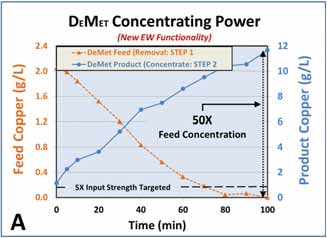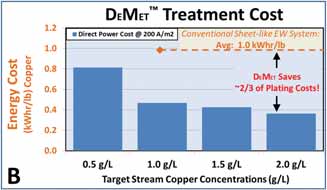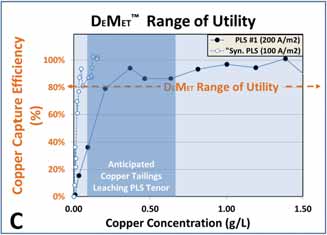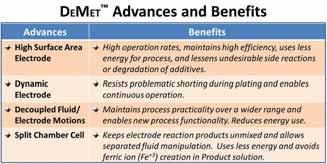







Electrolytic Technology Targets Residual Metal Values in Tailings
An innovative process offers a cost-effective approach to harvest new profits
from old material
By Patrick I. James








The Problem
Falling ore grades and exhaustion of accessible metal
reserves at active mining operations are straining production
capabilities and driving up costs in the face of unrelenting
demand resulting from global modernization. To combat this,
new ore sources—along with improved mining and processing
techniques—are constantly sought by miners. Processing
of tailings generated from earlier operations with higher cutoff grades, often via low-cost dump leaching, has been considered for decades, with limited success, as a readily available potential metal ore source. In most cases, the leach
product (Pregnant Leaching Solution or PLS) containing
these valuable metals is low in grade and too weak for economical processing by conventional SX-EW approaches.
While PLS strengthening technologies (such as ion extraction
and reverse osmosis filtration) and direct metal recovery by
advanced EW techniques have been considered for working
with low-grade and leached-tailings PLS, they have been met
with limited commercial success. As a result, a capabilities
gap exists for utilizing the readily available ore in tailings by
conventional technologies.
An Efficient Solution
Electrolytic DEMET technology can span this capabilities gap
and augment conventional leach and SX-EW operations to
seamlessly complement standard harvesting operations and
enable immediate new metal production from leached tailings.
It can facilitate metal production from tailings, either through
targeting direct metal generation from the low-grade PLS or by
strengthening the weak PLS obtained by conventional leaching
of waste-grade ores. The result of the strengthening treatment
is a cleaned solution loaded with the target-metal product,
ready for harvesting by conventional SX. Specifically designed
for practical treatment of dilute metal-laden solutions, the
DEMETmetal recovery capability enables new possibilities for
cost-effective metal reclamation from low-grade tailings
leachate and has proven to be effective on a variety of metals
and PLS samples. It is extremely versatile and adaptable to specific needs, yielding a suite of treatment possibilities to costeffectively and selectively process target-dissolved metals into
a variety of desirable product forms.
Deploying DEMET
Operations that can most readily benefit from DEMETaugmentation are mature brownfields, active mines with significant
amounts of easily accessible old tailings, and older mines with
leaching operations facing exhaustion of readily leachable ore
and ore meeting traditional economic cut-off grades, but with
abundant lower-grade or difficult to leach ore reserves.
Augmentation of such operations with DEMETcan open the way
to new production of metal leached from tailings or marginal or
difficult to leach ores now considered waste.
Augmented Tailings Leaching: A representative case of augmenting a traditional heap or dump leaching operation with an SX-EW circuit of 10,000 GPM/79 M lb/yr design capacity at PLS tenor of 2 g/L copper is considered. The original leach PLS is taken to contain 1.5 g/L of copper with 1.5 g/L ferric ion (with the ferric being removed during DEMETpre-treatment). This currently generates 62.7 M lb/yr to EW, which captures 95%, or 59.6 M lb/yr, representing 75% capacity. A new leaching operation is set up to leach the target ore (tailings or marginal ore) to bring production back to full capacity, and generates lowgrade PLS, which is input into the DEMETfacility along with a portion of the original leaching operation PLS. This balances the SX input by making space for the DEMETconcentrate product. DEMETproduct of 3 g/L copper is generated and returned to the original PLS for processing into copper metal via the SX-EW circuit. Although stronger DEMETproduct can be readily generated and generally improves the process economics, here it was held to 3 g/L copper for clarity of the analysis as stronger product requires consideration of pH-shift impacts in the processes.
Modeled Economics at Scale: The economic model for implementing DEMETaugmentation is based on a variety of representative pilot plant results, plus those discussed later in this article. Generally, the copper recovery cost, specific unit footprint, and system capex for a given production capacity decrease with increasing PLS copper tenor and scale sub-linearly with increasing system treatment flow rate capacity. Briefly, the total (end-to-end) production cost for new copper generated from the tailings leaching contains the DEMETtreatment cost, the total production cost of the existing operations cost (taken as $1/lb of copper) and the cost of the new leaching operation.
The cost for copper from the original heap diverted through the DEMET operation includes the DEMET treatment cost and the total production cost of the existing operations cost. The analysis was run for several PLS tenors spanning the concentration range expected from leaching copper ore tailings using median DEMETperformance and cost parameters; the tabulated results are shown in the figure below. Economically viable production from the augmented operation is achieved for tailings PLS tenor as weak as 0.2 g/L copper with anticipated total production costs generally being below $2/lb—providing more than a 38% gross margin at current average copper price expectations of $3.25/lb.
Site-specific application to an operating mine site leaching and SX-EW operation comparable to the above example and where leaching of tailings provides a PLS tenor of 0.33 g/L of copper with 1.7 g/L of ferric iron was performed using minesupplied values. The analysis found that with DEMETaugmentation and leaching of tailings at 26,800 GPM, total operation production could be increased by approximately 32%, with an incremental new copper total production cost of $1.85 to $1.95 and expected project payback period of less than six years.
Process Overview
DEMET uses an innovative electrically activated and selective
metal recovery platform technology developed over eight years
by the BPS team. The process has resulted in four issued
patents with several additional patents pending. The method
was originally created with support from the National Institutes
of Environmental Health Sciences (NIEHS) Superfund
Research Program to convert wastes into resources and economically reclaim metals from Acid Rock Drainage (ARD) at
legacy mining and industrial sites. U.S. Department of Energy
support (2011–2012) promoted its adaptation to enable lowerenergy copper production and thereby markedly reduce the
greenhouse gas impact of producing a pound of copper. The
technology advancements improve weak solution performance
and allow DEMETto supersede traditional limitations while providing new functional capabilities. The advantages created are
retained when stronger solution is treated by the approach.
The electrochemical DEMET treatment process comprises two steps that can be continuously employed, either separately or together, to address specific client needs. In the first step (loading), target metal is removed from the untreated feed stream and electrically loaded (electroplated) onto an electroactive substrate. The subsequent second step (stripping) removes the loaded metal from the substrate and strips it into a product solution where it can be accumulated and concentrated. In this manner, the target metal removed from a weak PLS stream—such as that from leaching of tailings—can be regenerated as a product, cleaned and strengthened to useful levels and suitable for normal SX-EW processing in an uninterrupted cycle. The first process step controls the overall DEMET treatment process metal processing efficiency and rate. This determines the practical limit of weak PLS treatment, and through the PLS tenor, how poor of ore grade or tailings might be processed using current leaching capabilities. DEMET advancements yield performance surpassing traditional EW limitations, consequently allowing practical processing of weaker streams and more efficient treatment than achievable by conventional commercial EW approaches. Unlike most conventional concentrating methods, DEMET’s electrolytic processing allows increasing product concentrations to high levels for minimal added cost over the basic metal capture cost.
Gauging Performance
Considering performance for DEMETtreatment of acidic copper
leach PLS from several working mines provides an industrially
relevant model with representative results illustrating salient
performance metrics. Efficient copper recovery at practical
rates is extended down to 0.2 g/L copper, well beyond the 0.5
g/L economic cutoff typical of the industry and appropriate for
low-grade PLS that might be expected from leaching of tailings.
High-product strengths readily exceeding economical SX input
strength requirements are also readily achieved at treatment
electrical costs well below that of conventional EW. Through its
design specifically for use with very weak solutions, DEMET
brings the possibility of use and success with much weaker
solutions than previously viable.
DEMET’s capacity to generate a cleaned and strengthened product suitable for introduction into an SX feed is seen in its ability to generate highly concentrated product at a consistent rate and high efficiency, even from very weak inputs. Panel A of the accompanying figure shows that the resulting product strength is not significantly limited by the input stream strength; the product is strengthened at a uniform rate even though the input strength falls from 2 g/L copper to 0.05 g/L during the period of operation. Product strength of more than 11 g/L copper can be readily generated and can represent more than a 50X strengthening of the DEMETinput feed.
Additional tailoring of the unit configuration and operation for specific conditions and needs can enable even greater strengthening to generate product streams strong enough for miners to economically harvest the treated metal via SX. Panel B displays the electrical cost of the DEMET electroactivation (kWhr/lb of copper) to remove and concentrate metal. It is only about one half of that required by conventional EW approaches under comparable conditions and still yields an improved cost, even for much weaker solutions than those commonly considered amenable to traditional EW.
As previously noted, step 1 (Load) controls the overall rate and efficiency at which the DEMETprocess may be applied and thereby defines the practical range of utility. Panel C presents representative copper removal results for PLS samples from working copper mines and illustrates the copper capture efficiency as a function of feed stream input copper strength (g/L). At 200 A/m2, DEMETaveraged 91% capture electrical efficiency for inputs containing from 1.7 g/L to 0.2 g/L copper, and exhibited a cell potential of 1 Vdc (at 1 g/L copper) to yield corresponding metal capture electrical activation cost of only 0.42 kWhr/lb. Higher treatment rates elevate the cell potential and reduce treatment efficiency somewhat. At 350 A/m 2 , the cell potential rises to 2 Vdc (at 1 g/L copper) while the electrical metal capture efficiency still averages 73% from 1.8 g/L to 0.3 g/L copper. Even better performance can be achieved when treating stronger streams. Lower treatment rates reduce the cell potential and allow efficient processing of weaker solutions, but lead to larger and more costly systems that challenge the overall process practicality. For example, at 100 A/m 2 more than 80% capture efficiency can be maintained down to 0.05 g/L and the electrical activation cost is roughly cut in half (cell potential 0.5 Vdc at 1 g/L copper) compared to operating at 200 A/m 2 .
Features Enhance Efficiency
DEMETachieves its superior performance and new functionality
as a result of advanced features that enable independent control and manipulation of key processing parameters. The system
design is closed, ameliorating uncontrolled release of any gases
generated as reaction byproducts, and it is amenable to
automation of product harvest and key consumables replacement, lowering labor and operations costs. DEMET utilizes a
high-surface area electrode that spreads out reactions by more
than 10 times compared to conventional sheet-like electrodes,
resulting in lower (better) operating voltages, less side reactions and efficiency losses, and overall a more gentle process while
by-passing traditional EW limitations to extend the range and
practicality of its use. The electrode is also dynamic, an aspect
that abates problematic shorting from dendrite formation constantly challenging electroplating-based processes. Employing
a split-cell design keeps products from the electrodes separated, controlling reaction contamination and fluid flow to allow
tailoring of treated solution and product to best meet client
needs, while also reducing treatment energy consumption up to
50%. The result is a greatly improved targeted process with the
new ability to generate a concentrated product that conventional EW cells can’t.
Site-specific Solution Development
Customized DEMETtreatments are developed through site-specific chemistry assessment and validation via rapid and lowcost scoping trials, culminating with on-site pilot verification
testing via slip-stream integration. This verifies performance
under the mine’s unique conditions while defining site-specific
response trends for cost/benefit analyses, and full-scale DEMET
solution customization prior to standard staged system implementation to reduce risk and maximize benefit. A small DEMET
unit housed in a customized 20-ft shipping container provides
a portable stand-alone testing pilot plant facility, operated manually with basic controls allowing maximum operational flexibility. Relevant controllable and process parameters are monitored
electronically, enabling continuous real-time recording of
salient parameters for key performance and economic metrics
assessment for performance and operation trend development.
DEMETnow provides a new opportunity for increasing production and extending mine life at mature brownfield operations, offering economic recovery of values from old tailings by
cost effectively capturing metal from low-grade PLS and
upgrading it to a form suitable for economic conversion into
metal by conventional SX-EW. By overcoming key barriers to
application on very weak streams and providing the ability to
electrically generate a concentrated product, versatile and
selective treatment solutions for converting waste ore into production are enabled. Modeling of application to old copper tailings at sites where PLS have decreased from design targets
indicates significant production boosts with compelling margins
can be achieved. Incremental NEW copper production is
expected to have a total cost of less than $2/lb and may allow
considerable extension of the productive lives of mines.
Patrick James, Ph.D., (pijames@bps09.com) is president of Blue Planet Strategies, a Wisconsin, USA-based firm that specializes in electrochemical system development for mine applications.